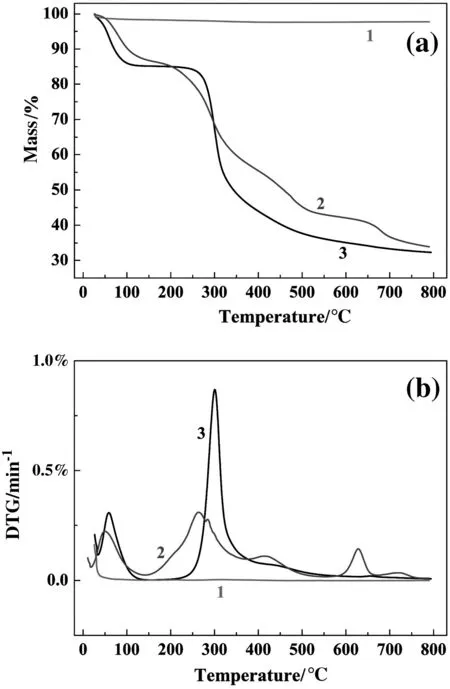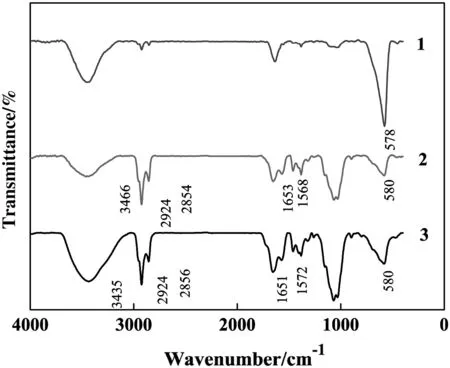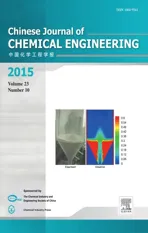Adsorption and degradation of nor floxacin by a novel molecular imprinting magnetic Fenton-like catalyst☆
2015-11-01MingjieHuangTaoZhouXiaohuiWuJuanMao
Mingjie Huang,Tao Zhou,Xiaohui Wu,Juan Mao
School of Environmental Science and Engineering,Huazhong University of Science and Technology,Wuhan 430074,China
Keywords:Fenton-like Nor floxacin Molecular imprinting γ-Fe2O3 Adsorption
ABSTRACT In this study,a novel magnetically separable adsorbent,molecular imprinting magnetic γ-Fe2O3/crosslinked chitosan composites(MIPs),were prepared by a microemulsion process.Adsorption and Fenton-like oxidative degradation of a model pharmaceutical pollutant nor floxacin(NOR)by using MIPs were investigated.Various characterization methods were used to study the properties of MIPs,and itis suggested that the hydroxyl groups are the main adsorption sites for NOR.MIPs present better selective adsorption for NOR than its reference antibiotic sulfadiazine.The NOR adsorption data can be well fitted by Langmuir isotherm model and pseudosecond-order kinetic model.The optimum pH range for NOR adsorption is 7-10.In addition,the MIP-catalyzed Fenton-like system(MIPs/H2O2)exhibits remarkably faster removal rate for NOR than the case of γ-Fe2O3/H2O2.The result indicates that MIPs will be a good functional material in decontamination of pharmaceutical wastewaters since MIPs can be magnetically recycled after the treatment.
1.Introduction
Fluoroquinolones can inhibit the proliferation of many Gramnegative and Gram-positive bacteria[1],so they have been widely used in human medicine.However,as a result of antibiotic overuse,public concern about fluoroquinolones has been greatly increasing in the past decades.The environmental concern of fluoroquinolone residuals in the aquatic environments is not only on their potential to increase antibiotic resistance,but also on their unfavorable ecotoxicity pro file[2].It has been reported that conventional biological processes(wastewater treatment plants)are incapable to remove antibiotic pollutants[3-5].
Advanced oxidation processes(AOPs),commonly with the highly reactive hydroxyl radical(•OH)as the main oxidative species,are ef ficientalternatives fordegrading bio-refractory antibiotics[6].As the second strongest oxidant after F2(E=2.8 V),•OH can oxidize target compounds non-speci fically at high reaction rate[7,8].Fenton reaction is one of the popular AOPs and has attracted much attention because of its distinct advantages,such as high ef ficiency and stability to treat a wide range of substances and free of secondary pollution[9].
Molecular imprinting technology allows synthesis of polymers with speci fic recognition ability towards target pollutants,selectively removing low-concentration contaminants in the presence of other substances that are thousands of times more abundant than the targets[10].Previous studies have showed that many contaminants can be gathered and removed by using molecular imprinting adsorbents,which are prepared by using contaminants themselves as templates,e.g.pharmaceuticals[11,12],synthetic dyes[13]and PAHs[14].
Chitosan is a deacetylated productof chitin,which is one of the most abundant polysaccharide in the world.Raw[15],grafted[16]and crosslinked[17]chitosan used as economical adsorbents are drawing great attention and showing signi ficant adsorption potential for removal of various contaminants.Amino(-NH2)and hydroxyl(-OH)functional groups on chitosan chains serve as electrostatic interaction and coordination bonds in the process[18,19].However,the dif ficulty in separating those powdery adsorbents from the system limits their applications.To solve this problem,chitosan powder is combined with magnetic materials.With the assistance of magnetic field,the material can be easily separated from the ef fluent[20].γ-Fe2O3is widely used as magnetic material due to their excellent magnetic properties,chemical stability and biocompatibility[21].
Compared to common adsorption materials,molecularly imprinted polymers(MIPs)exhibit high selectivity and af finity for low concentration template molecules[19].To our bestknowledge,combining Fenton reaction with magnetic MIP materials in pharmaceutical decontamination has been scarcely studied.Therefore,in this study,magnetic iron oxide nanoparticles coated with molecular imprinting chitosan are prepared.Atypicalantibiotic fluoroquinolone,nor floxacin(NOR),is chosen as the targetpollutantto evaluate the characteristics ofMIPs fortheirselective adsorption and catalyzing Fenton-like oxidation ofantibiotic pollutant.The objectives are to:(a)synthesize a novel magnetic γ-Fe2O3/crosslinked chitosan composite(MIPs)through a microemulsion process,(b)investigate the adsorption capacity for NOR of MIPs,and(c)explore the oxidation of NOR in the MIP-catalyzed Fenton-like system.
2.Materials and Methods
2.1.Materials
Chitosan(Molecular mass 2.1×105g·mol-1,degree of deacetylation 80.0%-95.0%)was purchased from Sinopharm Chemical Reagent Co.,Ltd(Shanghai,China).Nor floxacin(C16H18FN3O3,molecular mass 319.34 g·mol-1,purity ≥ 98.0%)and sulfadiazine were purchased from Tokyo Chemical Industry Co.,LTD(Japan).Their chemical structures are displayed in Fig.1.Other chemicals were of analytical grade and used without further puri fication.All solutions were prepared by deionized water.
2.2.Preparation of MIPs
Magneticγ-Fe2O3nanoparticles were prepared by hydrothermalcoprecipitation ofFe2+and Fe3+ionsin the presence ofammonia solution(NH4OH),according to literature[22].2.68 g FeCl2·4H2O and 3.11 g FeCl3·6H2O were dissolved in 250 ml deionized water.The solution was thoroughly mixed at room temperature for 30 min,followed by increasing pHrapidly to 11(±0.1)with the addition ofammonia solution(25%).The obtained γ-Fe2O3precipitates were multiplied,washed with deionized water and then collected and dried in an oven.
The preparation procedure of MIPs is described as follows.4 g chitosan and 1.5 g γ-Fe2O3are dispersed into 300 ml 100 mg·L-1NOR solution with continuous stirring for12 h.The mixture is washed and dissolved in 80 ml 2%(volume percentage)of acetic acid solution.The solution is dispersed slowly into a medium composed of 200 ml paraf fin and 4 ml emulsi fier(Span 80),with mechanical agitation for 30 min.2 ml methanal(37.0%-40.0%,volume percentage)is dropped slowly into the above reaction system.After 1 h,2 ml glutaraldehyde(25%,volume percentage)is added and the solution is stirred for 2 h.Then the solution pH is adjusted to 10-11 by using 0.5 mol·L-1NaOHand keptfor 2 h.The obtained particles are collected by a magnet and then washed with petroleum ether,ethanol and distilled water three times separately.Template molecule NORis removed by washing with 0.5 mol·L-1NaOH.The resultant MIPs are finally dried in an oven prior to the adsorption and degradation experiments.Corresponding non-imprinted polymers(NIPs)were prepared similarly but without the addition of template.
2.3.Characterization of MIPs
X-ray diffraction(XRD)patterns of samples were obtained in ambientair atroom temperature using a Bruker advanced D8 diffractometer.X-ray photoelectron spectrometry(XPS)analysis was carried out by using an Axis-Ultra DLD-600W electron spectrometer.Scanning electron microscopy(SEM)analysis was conducted by a Nova NanoSEM 450 instrument.Magnetic hysteresis loops were obtained at room temperature using a Lackshore EM4-HVA vibrating sample magnetometer.TG-DTG(Q600 SDT)analysis was performed under a nitrogen atmosphere from 25 °C to 800 °C with a heating rate of 10 °C·min-1.Fourier transforminfrared(FT-IR)spectra were measured atroom temperature on a Bruker Vertex 70 Fourier Transform instrument.
2.4.Batch adsorption experiments
Batch NOR adsorption experiments were carried out using a HZS-H thermostated shaker(Harbin Donglian Electronic Technology Development Co.,LTD)at 110 r·min-1.Adsorption volume of solution was 20 mland 30 mg MIPs were used in each adsorption.The initial solution pH was about 5 and speci fic temperature was kept in the reaction for 24 h.Then the suspension was filtered through 0.45 μm membranes before the analysis.NOR concentration was determined by using a high performance liquid chromatography(LC-15C,Shimadzu),equipped with a C18 column(4.6 nm×250 nm)and a UV detector.The mobile phase was a mixture of phosphoric acid(87%,0.03 mol·L-1,pH 3 ±0.1,adjusted by triethylamine)and acetonitrile(13%),with a flow rate of 0.8 ml·min-1.The detector temperature was set at 35 °C and the wavelength was set at 278 nm.
The amount of adsorption qt(mg·g-1)is calculated by

where c0and c are the initial and instantaneous NOR concentrations(mg·L-1),respectively,W is the mass of adsorbent(g),and V is the volume of solution(L).
2.5.NOR degradation experiments
In a typical experiment for MIP-catalyzed NOR degradation,the initial concentrations of NOR,MIPs and H2O2were 5 mg·L-1,0.6 g·L-1and 0.03 mmol·L-1,respectively.Initial pH was adjusted to 3 by using 0.25 mol·L-1HCl or NaOH.After mixing at least for 30 min to achieve adsorption equilibrium,the reaction commenced with the addition of H2O2.Samples were taken out at speci fic time intervals and 50 μl methanol was used to quench the reaction.All samples were filtered through 0.45 μm membranes before the analysis.
3.Results and Discussion
3.1.Characterizations of MIPs
Fig.2 shows six XRD diffraction peaks of γ-Fe2O3nanoparticles at 2θ of 30.26°,35.64°,43.34°,53.84°,57.36°and 62.96°,corresponding to(220),(311),(400),(422),(511)and(440)lattice planes of γ-Fe2O3[23].Typical diffraction peaks of γ-Fe2O3remain after embedding into MIPs.It indicates that γ-Fe2O3in the MIPs keeps its intrinsic phase of maghemite.
It should be noted that the XRD patterns of Fe3O4and γ-Fe2O3are analogous[24].High resolution XPS spectrum of Fe 2p from MIPs is presented in Fig.3.Adifference in the binding energy(BE)of3.5 eVis clearly observed when comparing the satellite of FeO(BE=715.5 eV,purely Fe2+)and α-Fe2O3(BE=719 eV,purely Fe3+)[25,26].It can be observed that the satellite binding energy of MIPs is 719 eV,representing the existence of pure Fe3+.

Fig.1.Chemical structures of nor floxacin(left)and sulfadiazine(right).

Fig.2.XRD patterns of γ-Fe2O3 and MIPs.

Fig.3.High-resolution scan of the Fe 2p region of MIPs.
Fig.4 shows the SEM images of γ-Fe2O3and MIPs.The prepared γ-Fe2O3uniformly disperses with diameter range of 200-250 nm,while MIPs present a smooth surface with a larger size of 60 μm averagely.The result indicates the dispersion of γ-Fe2O3nanoparticles in MIP interior and surface in the preparation of microemulsion.
Hysteresis loops of γ-Fe2O3and MIPs measured in fields between±8 kOe(1 Oe=79.5775 A·m-1)at room temperature are shown in Fig.5.Saturated magnetization of γ-Fe2O3and MIPs are 32.98 and 11.24 emu·g-1,respectively.MIPs could be easily separated and recovered magnetically after the usage.

Fig.5.Magnetization curves of γ-Fe2O3 and MIPs.
Fig.6 illustrates the TG-DTG curves of γ-Fe2O3,MIPs and crosslinking chitosan.TGcurve ofγ-Fe2O3shows thatmass loss over temperature range from 25 to 800°C is about 2.3%,indicating no signi ficant mass loss.Two mass loss stages of MIPs and cross-linking chitosan are observed at 25-800 °C.The first stage of mass loss is at 25-150 °C due to the evaporation of water[27].The second stage is between 200°C and 500°C,ascribing to the decomposition of chitosan in the MIPs.
Fig.7 shows the FT-IR analysis for three samples(γ-Fe2O3,MIPs before/after adsorption ofNOR).For MIP and MIPafteradsorption(MIP-A)samples,strong bands in the region of 1653-1558 cm-1are attributed to amine deformation vibrations,while the band at 1568 cm-1denotes N-H bending vibration overlapping amide II vibration and the band at 1645 cm-1refersto amide Ivibration[28].Moreover,C-Nstretching vibrations in the region of 1190-920 cm-1overlapped the vibrations from the carbohydrate ring[29].For γ-Fe2O3nanoparticles,peaks at 580 cm-1could be related to Fe-O groups.It is obvious that γ-Fe2O3particles are introduced into MIPs successfully.In addition,peaks around 3450 cm-1representing hydroxyl groups(-OH)are found in all three samples,demonstrating that hydroxyl groups are the main adsorption sites for NOR.
3.2.NOR adsorption by MIPs
3.2.1.Selective NOR adsorption by MIPs
As presented in Fig.8,MIPs exhibit strong selective adsorption for NOR compared to its reference antibiotic sulfadiazine.In a solution containing 0.11 mmol·L-1NOR and 0.11 mmol·L-1sulfadiazine,the equilibrium adsorption capacity of NOR and sulfadiazine are 3.56 and 13.83 μmol·L-1,respectively.It indicates that MIPs prefer adsorbing sulfadiazine rather than NOR.With NOR-molecular-imprinting,NOR adsorption capacity increases signi ficantly,while adsorption capacity of sulfadiazine decreases from 13.83 μmol·L-1to 3.19 μmol·L-1.Fig.7 shows that the main adsorption sites of NOR on MIPs are attributed to plenty ofhydroxylgroups in chitosan.Hydrogen bond forms in the molecular imprinting process between MIPs and NOR,leading to much higher binding ef ficiency for NOR molecule compared to its reference antibiotic sulfadiazine molecule.It is evidenced by distinct adsorption behavior of NOR and sulfadiazine in a selective adsorption experiment as presented in Fig.8.Obviously,the imprinting method increases speci fic binding sites in the cavities ofthe polymer and enhances its molecular recognition ability[14].It also suggests that the prepared MIPs are able to selectively adsorb NOR in pharmaceutical wastewaters.

Fig.4.SEM micrographs of γ-Fe2O3(a)and MIPs(b).

Fig.6.TG(a)and DTG(b)curves of γ-Fe2O3(1),MIPs(2)and cross-linking chitosan(3).

Fig.7.FT-IR spectra of γ-Fe2O3 nanoparticles(1),MIPs(2),and MIPs-A(3).

Fig.8.Selective adsorption of NOR compared to sulfadiazine.
3.2.2.Adsorption isotherms of NOR by MIPs
Equilibrium adsorption isotherm is useful to analyze adsorption mechanism.In our study,adsorption equilibrium data were collected at various NOR concentrations(10-35 mg·L-1),temperature 30 °C and pH 5.To fit the data,linearized forms of the Langmuir isotherm and Freundlich isotherm models are used[30].

where ceis the equilibrium concentration of NOR in solution(mg·L-1),qeis the adsorption capacity of adsorbent at equilibrium(mg·g-1),qmis the maximum adsorption capacity of adsorbent(mg·g-1),b is the Langmuir equilibrium constant related to the af finity of binding sites(L·mg-1),KFis the Freundlich equilibrium constant representing the adsorption capacity(L·mg-1),and n is the exponential factor.
The fitting results and related parameters are presented in Fig.9 and Table 1.The validity of model is checked by correlation coef ficient R2.The correlation coef ficientfor Langmuir isothermmodel and Freundlich isotherm model are 0.990 and 0.659,respectively,so the Langmuir isotherm model is better in simulating the NOR adsorption by MIPs.In general,the Langmuir isotherm model assumes monolayer coverage of adsorbate on a homogeneous adsorbent surface.Therefore,it could be concluded that the sorption of NOR on MIPs is mainly monolayer.A maximum Langmuir adsorption capacity of NOR is calculated as 8.55 mg·g-1.

Fig.9.Langmuir(a)and Freundlich(b)isotherm plots for the adsorption of NOR on MIPs.

Table 1 Isotherm model parameters of NOR adsorption onto MIPs
3.2.3.Adsorption kinetics of NOR by MIPs
To investigate the dynamics of adsorption of NOR onto MIPs,the adsorption kinetic experiments were performed with the adsorbent dosage of 0.03 g·L-1at initial NOR concentration of 35 mg·L-1,initial pHof5,and adsorption temperature of30°C.Three common adsorption kinetic models,i.e.pseudo- first-order kinetic,pseudo-second-order kinetic and intraparticle diffusion model,are employed to fit the experimental data[31].
The linearized forms of the three rate equations are as follows.

where qeand qtare the adsorbed amounts of NOR(mg·g-1)at equilibrium and at time t,respectively,k1(min-1)and k2(g·mg-1·min)are the rate constants,ki(mg·g-1·min1/2)is the intraparticle diffusion rate constant,and a(mg·g-1)is a constant for the thickness of boundary layer.
The fitting patterns and parameters of three models are shown in Fig.10 and summarized in Table 2,respectively.The correlation coef ficient(R2=0.978)of pseudo-second-order kinetic model is much higher than that of pseudo- first-order kinetic model(R2=0.740)and intraparticle diffusion model(R2=0.691).It indicates that the kinetics of NOR adsorption onto MIPs follows the pseudo-second-order kinetic model.This result demonstrates that the adsorption of NOR is mostly ascribed to chemisorption mechanism.Similar phenomena have also been observed in adsorption of reactive dye on chitosan beads[32].
Generally,the adsorption process can be divided to three steps:(a)diffusion in boundary layer;(b)sorption of ions onto sites;and(c)intraparticle diffusion.According to Eq.(6),the intraparticle diffusion rate constant is calculated from the plots of qtversus t0.5for MIPs.The correlation coef ficient(R2)is only 0.691,indicating that more than one process affect the NOR adsorption.Besides,the large a value(2.4 mg·g-1)suggests that intraparticle diffusion is not the ratelimiting step and the boundary layer diffusion controls the adsorption to some degree[33].
3.2.4.Effect of initial pH on NOR adsorption
Adsorption experiments at different initial solution pH were carried out.The concentration of NOR was 35 mg·L-1with an adsorbent dosage of 0.03 g·L-1,and the temperature was 30 °C for 24 h.Fig.11 shows that MIPs can ef ficiently adsorb NOR in a broad pH range of 3-10.The maximum adsorption amount of NOR is obtained at initial pH of 10.Due to the p Kavalue of 6.3-7.0 in the basic solution,-NH2groups in chitosan chains are mostly protonated to form-.At the same time,NOR molecule with a carboxyl is ionized to NOR anion.Increased electrostatic attraction between NOR anion and-will enhance the adsorption of NOR on MIP surface[34].At pH 12,both NOR molecule and chitosan possess negative charges,hindering the adsorption process.On the other hand,more acidic pH(e.g.1.6)will lead to a sharp decrease in the adsorption amount of NOR,because γ-Fe2O3particles in MIPs are dissolved so that the adsorption sites are occupied by the released ions.

Fig.10.Pseudo- first-order kinetic(a),pseudo-second-order kinetic(b)and intraparticle diffusion(c)plots for the adsorption of NOR on MIPs.(Initial conditions:c NOR=35 mg·L-1,c MIPs=0.03 g·L-1,T=30 °C).
3.3.Fenton-like degradation of NOR in MIP/H2O2 system
Fig.12 shows the degradation of NOR in two Fenton-like systems,γ-Fe2O3/H2O2and MIPs/H2O2,indicating that NOR is well degraded in the MIP-catalyzed Fenton-like system.The pseudo- first-orderkinetic can be applied in the Fenton-like oxidation process of NOR.The kobsof NOR degradation is calculated as 0.0012 min-1.The enhancement of NOR degradation ef ficiency in the MIP/H2O2system can be mostly ascribed to selective adsorption and enrichment of NOR on the MIP surface.In a heterogeneous Fe(III)based Fenton-like system,pollutant degradation is commonly rate-limited by the mass transfer in the solid-liquid interphase[35].In this case,MIPs improve the solid-liquid interphase mass transfer signi ficantly,enhancing the NOR degradation obviously.The dissolved Fe3+ion during the reaction has also been examined.Its concentration(10 μm·L-1)is relatively low,suggesting that MIPs do not dissolve in the Fenton reaction.Obviously,MIPs could be used as an ef ficient catalyst for Fenton-like reaction.It is expected that MIPsare dual functional materials in treating pharmaceutical wastewater,not only a speci fic adsorbent but also an oxidation catalyst.

Table 2 Parameters of kinetic models for simulation NOR adsorption onto MIPs

Fig.11.Effect of initial pH on the adsorption of NOR by MIPs.
4.Conclusions
In this study,molecular imprinting magnetic γ-Fe2O3/crosslinked chitosan composites(MIPs)were prepared by microemulsion process using γ-Fe2O3nanoparticles as magnetic material and chitosan as basic adsorbent.Characterization results indicate that the hydroxyl groups are the main adsorption sites for NOR.Selective adsorption of NOR by MIPs is successful compared to its reference antibiotic sulfadiazine.Langmuir isotherm model is better than Freundlich isotherm model to fit NOR adsorption by MIPs,indicating that the sorption of NOR is mainly monolayer adsorption.The pseudosecond-order kinetic model is appropriate for simulating the adsorption kinetics of NOR.pH affects the adsorption amount of NOR greatly and the optimum pH value is about 10.It is demonstrated that the NOR degradation in the MIP/H2O2Fenton-like system follows the pseudo- first-order kinetic with a kobsvalue of 0.0012 min-1.After the reaction,MIPs can be recycled magnetically.Exploration of the adsorption mechanism and evaluation of recyclability of MIPs are to be further investigated.

Fig.12.Fenton-like degradation of NOR in a MIPs/H2O2 system.(Initial conditions:c H2O2=0.03 mmol·L-1,c NOR=4.2 mg·L-1,c MIPs=0.6 g·L-1,pH=3).
杂志排行
Chinese Journal of Chemical Engineering的其它文章
- Synthesis and characterization of switchable ionic compound based on DBU,CH3OH,and CO2☆
- Preparation and simulation of a taro flavor☆
- Preparation and characterization of monodisperse zirconia spherical nanometer powder via lamellar liquid crystal template method
- Effect of PSA tin plating process on trace lead in tin coating☆
- Biological treatment of high wastewater using an ammonia-tolerant photosynthetic bacteria strain(ISASWR2014)☆
- TG-FTIR analysis of pyrolusite reduction by major biomass components☆
